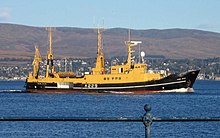Hall, Russell & Company
Hall, Russell & Company, Limited was a shipyard in York Place, Aberdeen , Scotland , best known for manufacturing fishing vessels.
history
Start time
The company was founded in 1864 by the brothers James and William Hall, as well as the Glaswegian engineer Thomas Russell, when they took over the Aberdeen Iron Works foundry to manufacture marine machinery and ships. One of the brothers, William Hall, had previously operated a well-known sailing shipyard with his father, Alexander Hall, under the name Alexander Hall & Co. , right next to the site of the new shipyard.
The first ship was the 1868 from iron resulting steamer Kwang Tung . In the mid-1880s, ship manufacturing was switched from iron to steel . The company was converted to a limited company form in 1897 (other source 1904) . In the same year a series of 14 large steamers for the shipping company John T. Rennie and Co. was started. In 1880 the engine of the first steam tug built in Aberdeen, the North Star , was established, thus establishing a tradition in the construction of fishing vessels that continued until 1974. The shipyard program was expanded step by step, and at the turn of the century included the construction of trawlers, cruisers , coastal ships and necklaces . In 1907 Hall Russell employed about 1200 people.
First and Second World War
At the beginning of the First World War , in addition to steam-powered stern catchers, the shipyard's specialty, all types of freight and passenger steamers up to a length of around 150 meters, ship steam engines and boilers as well as the repair of ships and machines were offered. During the war, mainly trawlers and driftnet fishermen were built on behalf of the Admiralty and for local clients such as the Aberdeen Steam Trawling and Fishing Co.
In the interwar period, coastal ships, trawlers and ferries were created. In the 1920s, the first orders for the construction of large liner freighters for the transatlantic service were also won. The construction of the world's first diesel-electric driven tractor fell into this year.
During the Second World War made Hall Russell frigates , six corvettes of the Flower class , minesweepers , landing craft , rescue boats and other small naval units. Fishing vessels and tugs continued to be made for civil purposes. In 1942 the Burntisland Shipbuilding Company took over the shipyard.
post war period
From 1949 to 1969, the shipyard built 32 large colliers and general cargo ships . Under the Burntisland shipbuilding aegis, Alexander Hall & Company was added to the shipyard in 1953 . From 1955, the shipyard was able to show an order book filled with medium-sized sugar freighters , mini bulkers and smaller combi ships .
In addition to a large number of trawlers, the 1960s also saw a construction contract for the Discovery , a marine research vessel for the National Environment Research Council and a ferry trio for the shipping department of the Department of Agriculture and Fisheries for Scotland, the Hebrides class .
In 1968 the Burntisland Shipbuilding Group was liquidated. Hall Russell went on to build ferries and RoRo freighters . A series of coastal tankers, but also larger tankers, coasters and ships for the Mediterranean service followed. In 1971 Hall Russell built the 10,500- ton freighter Thameshaven for a Rotterdam shipping company, the largest ship ever built in Aberdeen .
In the 1970s, a number of sea patrol ships and torpedo recovery boats for the Royal Navy were also built .
Nationalization and reprivatisation
On July 1, 1977, the shipyard was incorporated into the state-owned British Shipbuilders Corporation and classified by the government as a naval shipyard, although it was traditionally known for building smaller freighters and fishing vessels. Naval ships for the Royal Navy and for Hong Kong were built . Although Hall Russell was able to win a £ 19 million sterling contract for the construction of a station wagon for the government of the island state of St. Helena after being re-privatized in 1986, it had fundamental difficulties in obtaining civil contracts due to its classification as a naval shipyard in 1977. In 1988 Hall Russell became insolvent and in 1989 A & P Appledore International bought the shipyard and continued it as A & P Appledore International (Aberdeen) . In the same year, however, Hall Russell launched the last ship, the RMS St. Helena , after the delivery of which in 1990 the shipyard continued to work for almost two years with repair orders and was then closed.
today
After the closure, the former shipyard became the Telford Dock, a deep water pier, which is mainly used by the North Sea oil industry. The dry dock Hall Russell's under the name River Dee Ship Repairers still used by the A & P Group. The shipyard's social club was also closed in 1992, only a youth football team continues to bear the name Hall Russell.
Individual evidence
Web links
- Hall, Russell & Company at Grace's Guide (English)


